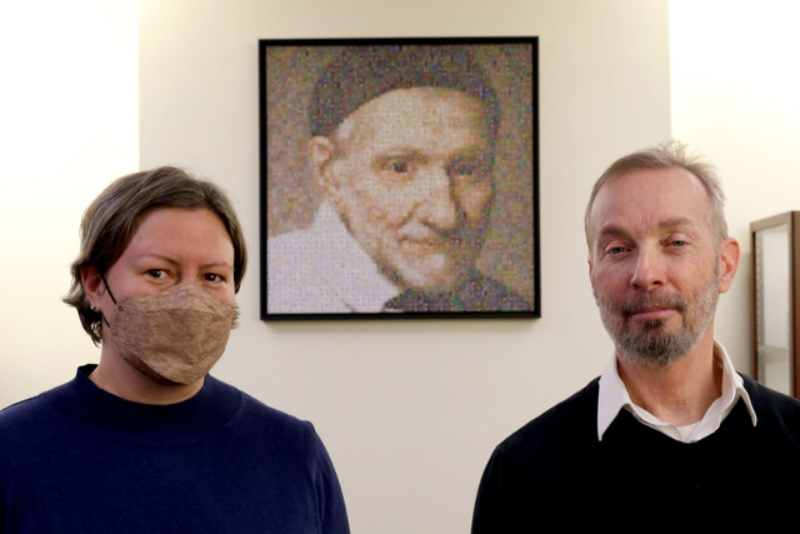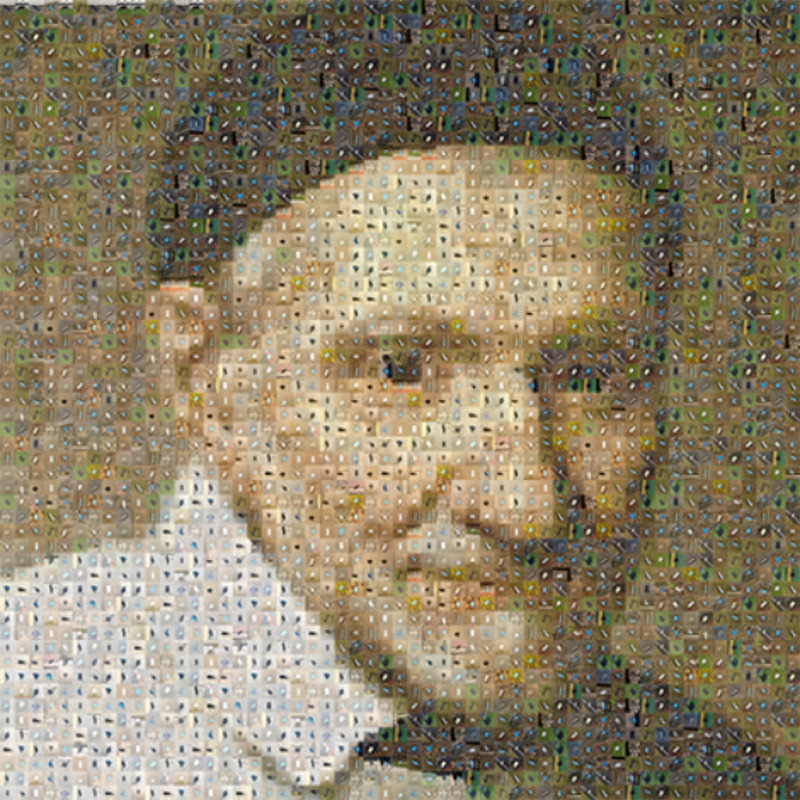 Professors Robin Hoecker and Jay Baglia flank a framed version of their Vincent de Paul photo mosaic artwork displayed on the 12th floor of DePaul’s College of Communication. Photo credit: Myat Min Soe, graduate student, public relations and advertising.
Professors Robin Hoecker and Jay Baglia flank a framed version of their Vincent de Paul photo mosaic artwork displayed on the 12th floor of DePaul’s College of Communication. Photo credit: Myat Min Soe, graduate student, public relations and advertising.In September 2021, as the COVID-19 pandemic continued to rage around the planet, Jay Baglia began documenting its familiar detritus: masks discarded on the ground. Phone camera poised, Baglia, an associate professor in DePaul's College of Communication (CMN) whose academic focus includes health communication, started snapping pictures during his commute to work and walks around town. Before long, he realized he'd accumulated dozens of photos of discarded masks.
“So I kept taking pictures over the winter and through the following spring and summer, even when I traveled to Australia, Canada and the East Coast," Baglia recounts. “Eventually I took several hundred. It's an iconic image that marks this experience we all shared worldwide. And while the masks are basically the same, it's the backgrounds—sidewalks, leaves and grass, snow and ice, the floor of a CTA car, athletic fields—that offer the context of how the pandemic intersected with each individual life."
Baglia mentioned his project to Robin Hoecker, a CMN assistant professor and photojournalist whose work explores how images are used to process trauma, conflict and periods of upheaval and systemic change.
Hoecker saw the potential to transform the photos into an art piece with layers of meaning. Using a photo mosaic app, Hoecker turned each mask photo into a tile in an interactive, composite image that re-creates Simon François de Tours' 17th century portrait of St. Vincent de Paul
The
interactive mosaic, titled “The Masks We Wear (or Don't)," compiles hundreds of Baglia's photos in intricate patterns of tonal gradations to piece together the portrait. When viewers click on different parts of the image the individual mask photos pop up. A mask on green grass makes up part of St. Vincent's cap; a mask on the gray sidewalk is part of the image of his face.
 Hoecker compiled hundreds of Baglia’s photos in intricate patterns of tonal gradations to piece together the portrait "The Masks We Wear (or Don’t)."
Hoecker compiled hundreds of Baglia’s photos in intricate patterns of tonal gradations to piece together the portrait "The Masks We Wear (or Don’t)."The number of tiles—3,025—is roughly equivalent to the number of people in the U.S. who die
each week from COVID-19 as of February 2023.
Hoecker settled on St. Vincent after initially considering iconic Chicago sights such as the city skyline as well as current public figures identified with the pandemic, such as former White House chief medical advisor Anthony Fauci.
“St. Vincent de Paul was all about providing health care to the most marginalized people," Hoecker says. “That message really resonated with me, especially with regard to COVID. What must be done? How do we reach the most marginalized? That's who was the most affected by COVID."
Masks have become the iconic symbol of the pandemic, Hoecker says, partly because photojournalists couldn’t readily document people privately confronting infection and grieving in isolation.
“Coronavirus is also invisible to the naked eye, so we don’t have those images that we normally would for a traumatic event,” she adds. “[The pandemic] was like a slow-moving train wreck and an invisible trauma in a lot of ways. It’s hard to visualize that, so the mask becomes the substitute.”
The photo mosaic’s micro and macro layers mirror the duality of people’s private struggle as well as the pandemic’s broader impact on society.
Hoecker has also interpreted the pandemic artistically in other ways. She created a photo essay on how teachers adapted, instructed her students to document their personal lives while taking classes remotely, and collaborated with DePaul Associate Professor of English Rebecca Johns Trissler on the book “Virus City,” a collection of Chicagoans’ first-person accounts during the pandemic that was published by DePaul’s Big Shoulders Books. She’s working on a pandemic-focused photo essay for a book on parenting in the age of media overload, co-edited by her colleague Kelly Kessler, a professor in CMN’s media and cinema studies program.
Viewing abandoned masks through a Vincentian lens may not have been the project’s impetus, but infusing media with meaning often involves personal journeys of discovery, according to these collaborators.
“A little project like ours helps expand the nature of what health and health communication is,” Baglia adds. “There are going to be a lot of ways in which artists address this. I’m thinking about theatre plays and even musicals—‘Coronavirus!’ with an exclamation point. But that’s what we do as human beings. We have to find ways to make sense of our experience.”
Originally published in DePaul Magazine.